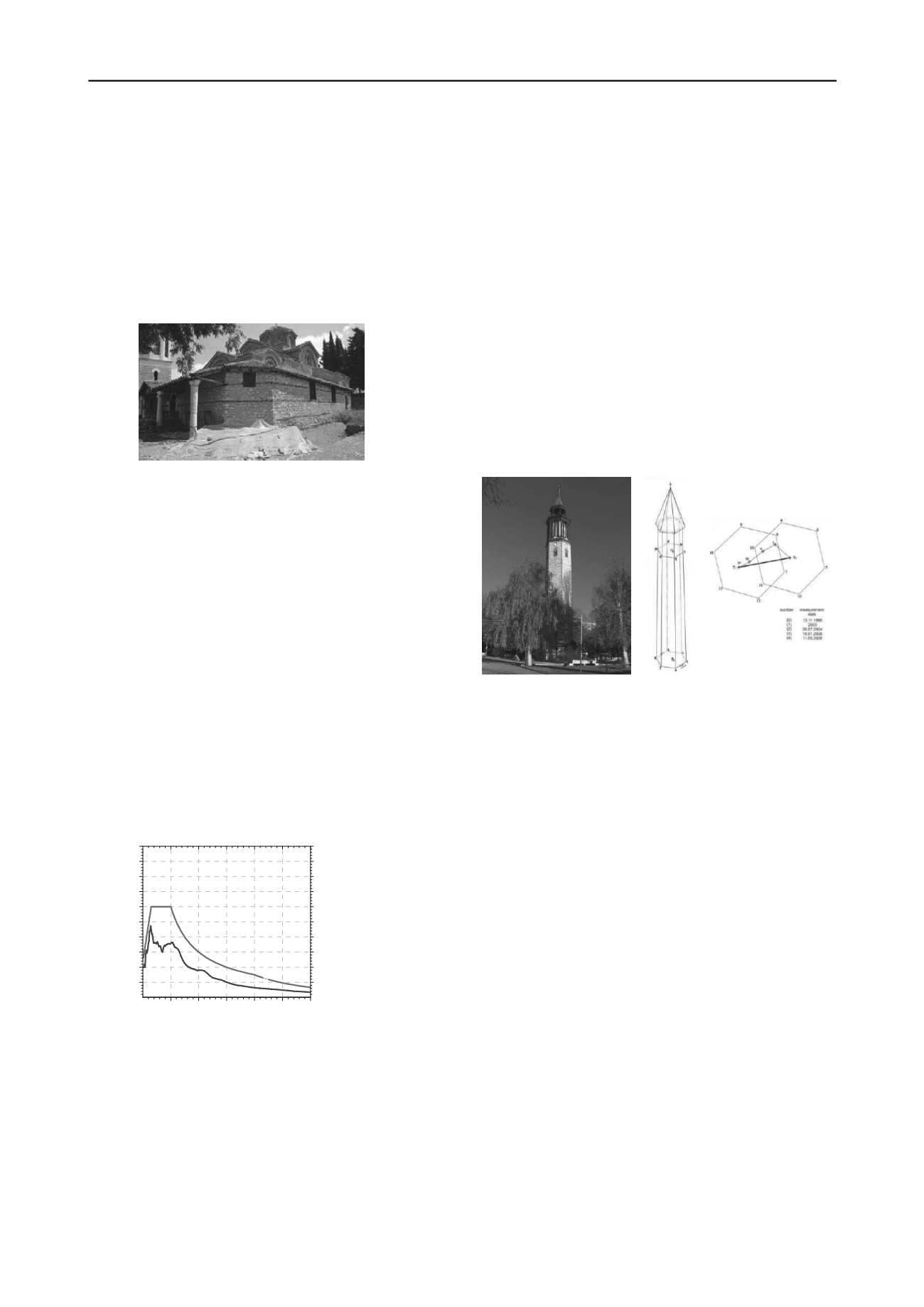
3131
Technical Committee 301 /
Comité technique 301
Spectral Ac
Period(sec)
celeration / PGA
0.0
0.5
1.0
1.5
2.0
2.5
3.0
3.5
4.0
4.5
5.0
The parameters for analysis of the structure of St. Mary
0.0
0.5
1.0
1.5
2.0
2.5
3.0
igure 4. St. Mary Peribleptos chur
d
The maximum expected a
at bedrock have been
btained by seismic haza
is. The results for the
e return peri
.25 g, in accordance with
Figure 5. Mean normalized response spectrum and normalized spectrum
in accordance with EC8 – ground type B, for 5% da ping
The results from the analysis of the seism onse of the
site show that the effects of amplification of the local soil are
not much expressed (Sesov et al., 201 . The dynamic
h will indirectly
pr
ic
of Macedonia and beyond, in the Balkan region. It is a unique
ed until present in its
.
earch works for the
ilep, Macedonia
yze the existing structure together
a superstructure principle more detailed
applied. The application of the
e. equivalent linear
interaction problem
to be analyzed in phases so that each phase is solved
ind
to the situation with the
contributing to further inclination be sustained and
tra
Peribleptos church in Ohrid for the effect of seismic excitations
expected at the site, have been defined on the basis of the results
obtained from the performed investigations that are described in
details in the previous case study.
Based on the realized investigations and the obtained results
on the seismic potential of the site of the St. Mary Peribleptos
church in Ohrid, the following conclusions are drawn:
The data on the seismic activity of the wider area of the site
point to moderate exposure to earthquake effects with expected
maximum magnitudes of M=6.9.
F
ch, Ohri
ccelerations
rd analys
ods (Table 2)
o
representativ
range between 0.20 and
the recommendations given in
arthquake Resistance -
0
Eurocode 8: Design of Structures for E
Part 1: General Rules, Seismic Actions and Rules for Buildings
for Damage Limitation Requirements – TDLR=95 years and
Non-Collapse Requirements TNCR =475 years
The geotechnical boreholes and geophysical measurements
confirmed the existence of a dominant geological formation at
the site: below surface - plate-like limestone with presence of
superficial alluvial zone with humus cover. The measured
velocities of seismic waves show the existence of ground type
“B” in accordance with the Eurocode 8 classification.
The performed analyses of seismic response of the site point
to several important issues, namely that the predominant periods
of the site are in the range of T=0.13-0.15 s . According to the
data received from the design engineers, the predominant
periods of the structures range between Тchurch =0.2 s,
Тbellfry= 0.29 s and Тlodging=0.17s. If a comparison is made
with the predominant periods of the site, it can be concluded
that there is no danger as to occurrence of resonance effects.
m
ic resp
1)
amplification factor ranges within 1.15 – 1.20.
Based on the analyses of the seismic risk, the maximum
acceleration as one of the main seismic parameters for seismic
analysis is given in function of the return period and the design
engineer also has the possibility to adopt a maximum
acceleration level based on the adopted level of acceptable risk
and serviceability period of the structure whic
ovide the return period.
.
In the case of the St. Mary
Peribleptos church in which the soil conditions are mainly
represented by stiff soils and rock, the amplification does not
play a significant role regarding the response of the structure.
3 CASE STUDY 3 - CLOCK TOWER
The Clock Tower in Prilep (Figure 5) was built in 1858, on the
location of an older wooden Clock Tower, which was burnt to
the ground. It is an particularly important structure in Republ
structure of this kind that has been preserv
authentic architectonic and structural form
A problem which is to be solved as soon as possible is the
evident inclination of the tower, i.e., the displacement of the
vertical axis in respect to the vertical line in west and southwest
direction by which the existing stability of the tower is
disturbed in static, and particularly dynamic conditions. Since
1998, there have been different kinds of res
purpose of precise measurement of the extent and the direction
of the inclination and defining the reasons for this problem.
Figure 5. The Clock Tower in Pr
or the purpose to anal
with the soil condition,
xplained by Wolf, 1985 is
F
e
superposition principle, in case of linear i.
methods, enables the dynamic soil-structure
ependently. As first step the structural components of the
tower are analyzed where the soil is simulated by springs
stiffness, and as second step the stress strain conditions in the
soil are analyzed together with the foundation structure where
the tower is added as continuous load.
The main model has been analyzed for the effects of dead
weight of the tower and seismic forces according to the national
regulations. The effects of the seismic forces increase the
inclination in the direction as well as reduce the global safety
coefficient. The inclination angle of the tower in this case of
effects has increased for 40% in respect
effects only due to the dead weight. This situation clearly points
out that the capacity of the existing state is limited and that the
deformation capacity of the tower along with the foundation
soil is exhausted regarding maintenance of a satisfying level of
safety. Therefore decision for strengthening the Tower has been
made.
The main concept of this technical solution for strengthening
is to reduce and prevent further uncontrolled inclination of the
tower by means of additional structural elements (RC jackets,
pile slab and piles) that are connected and make an integral
structure (figure 7). This structural unit enables that additional
effects
nsferred to the soil layers with good strength-deformability
characteristics and provides, at the same time, the required
stability and safety of the Tower under seismic loads that, in the


